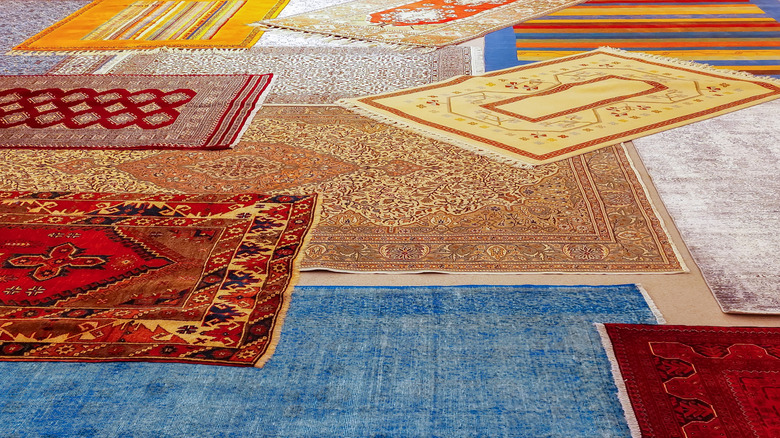Layer Your Area Rugs In One Space To Make Your Living Room's Colors Pop
If you've been looking to get the most out of your area rugs, layering is a great place to start. Rugs do more than serve a practical purpose — they are often used to create a focal point, add texture and color, and help pull the entire space together. That said, some styles just don't hit the mark once you incorporate them, whether they feel too bland, too small, or simply lack the kind of impact you're looking for. One of the most common mistakes in living rooms is choosing the wrong rug size. It's all about finding the right balance to fit comfortably among your furniture. Even if you do source the right size, it's not always easy to find one in the pattern or color you envision. If you're looking for a solution that can fill a large amount of space while accentuating your color choice, it might be worth considering a unique approach: Layering several small area rugs together in the same space to create a large, colorful statement rug.
When you layer multiple rugs together, you can customize your area with various patterns and shades to get a unique look that complements your design. There are plenty of expert design tips for layering your area rugs that can guide your process, whether you're mixing patterns, colors, or textures. While it's an idea that many people may not consider, it actually presents a wonderful opportunity to enhance these aspects of your floor's focal point and add character to your space overall.
Combine small area rugs into one big statement
If you want your area rug to give your living room a pop of color, designers recommend using rugs with patterns and colors that coordinate rather than mimic your space's palette, allowing you to create an exciting color story throughout your home. There's nothing wrong with leaning into patterned carpet trends here, especially if they share common tones for a cohesive look. Large patterned rugs can make a room feel bigger by shifting focus to bold and colorful designs, drawing attention away from the space's size. If you want a more blended, seamless look, make sure you pick rugs with a repeating pattern that will align when paired. In this case, styles like plaid, stripes, or florals can be easier to match up.
It's best to maintain some kind of common theme between your rug choices, whether it's the color, the texture, or a similar pattern — but the key is to experiment and see what works best in your living room. To keep your rug combination safe from tripping hazards, aim for styles with similar thickness, add a non-slip base underneath, and secure the rugs to each other with fabric tape. If you're looking to layer rugs to avoid the high costs of custom designs, thrift stores or online marketplaces can offer affordable vintage options to pair. Sometimes, the hunt is the best part of the design process, so take your time when pulling your pieces together.
